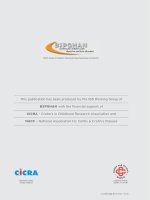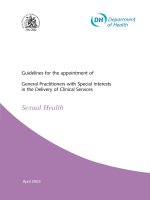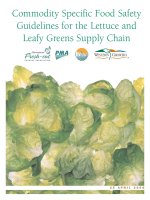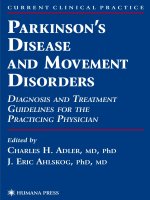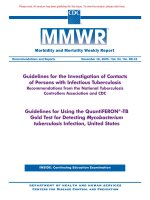PROGRAM COMMITTEE GUIDELINES FOR THE ANNUAL CONFERENCE
Bạn đang xem bản rút gọn của tài liệu. Xem và tải ngay bản đầy đủ của tài liệu tại đây (193.77 KB, 13 trang )
American Society for Environmental History
PROGRAM COMMITTEE
GUIDELINES FOR THE ANNUAL CONFERENCE
TABLE OF CONTENTS
General Objectives of the Guidelines………………………….……..2
General Responsibilities of the Program Committee………….……...2
Conference Theme……………………………………………….…...3
Call for Papers and Posters…………………………………………...3
Speakers and Special Events………………………………………....3
Evaluation of Proposals……………………………………………....4
Acknowledgment Notices………………………………………..…..5
Program Spreadsheet……………………………………………..…..5
Audio Visual……………………………………………………...….6
Instructions to Session Chairs……………………………………..…6
Advertising…………………………………………………………..6
Travel Grants…………………………………………………….…..7
Changes to Program………………………………………………....7
APPENDIX
•
Call for Papers and Posters
1
American Society for Environmental History (ASEH)
Program Committee Guidelines
General Objectives of the Guidelines
ASEH’s annual conference is one of the most important services that the organization offers its
members. This meeting provides a forum for scholars and professionals from a variety of
disciplines to exchange ideas about their work and to learn about new developments in the field
of environmental history. It also allows participants to renew acquaintances with distant
colleagues, while building new relationships. It encourages established scholars to interact with
students, who represent the future of ASEH as well as that of the field. Lastly, the annual
meeting increases the visibility and credibility of ASEH, and ideally should result in increased
membership.
Given the importance of the annual conference, ASEH's Executive Committee has prepared the
following guidelines to assist the program committee in its planning. Please note that there is a
companion set of guidelines for the local arrangements committee. These guidelines are
intended to provide a general framework rather than to dictate a rigid blueprint. It is essential to
realize that these guidelines do not provide step-by-step instructions for what to do in every
instance and every possible set of circumstances. ASEH recognizes that each meeting is unique,
affected by factors that vary from year to year, such as the conference theme, meeting location,
hotel facilities, anticipated level of attendance, funding available for that particular year, and
potential participation of other learned societies (such as in a joint conference).
ASEH also encourages its program committees to think creatively and to try new things. When
in doubt, the program committee should consult the ASEH executive director, who might also
consult the president and vice president. Every ASEH conference program should evolve as a
result from interaction among program committee members and consultation with the executive
director and officers.
The following guidelines will identify perimeters, indicating areas of established approach and
areas of flexibility.
General Responsibilities of the Program Committee
The program committee, which includes the Local Arrangements Chair, is responsible for the
intellectual content of the meeting. This responsibility involves selection of the conference
theme, paper sessions, poster sessions, and plenary and keynote speakers. It could also include
invitations to related organizations that might want to participate in the meeting, as well as
assisting the executive director in advertising for the meeting.
The following sections outline the major tasks of the program committee, along with schedules.
2
It is important to recognize that the timetable is driven by the local arrangements committee's
need to publish and distribute the program by December of the year preceding the conference.
Conference Theme
The ASEH vice president will appoint the program committee and its chair two years before the
meeting. If the ASEH executive committee has approved a joint conference with another
organization for a particular year, the program committee might have two co-chairs – one from
ASEH and one from the other group. Typically, the program committee will consist of at least
three members in addition to the local arrangements chair, who should be included in all
meetings and correspondence. The chair will call meetings and coordinate the tasks listed below.
The first task is to select a conference theme. The only requirements for the theme are that it
relate to environmental history, be broad enough to encompass a wide array of posters and
papers, and reflect the distinctive features of the area where the meeting will take place.
Schedule: The conference theme should be selected within 15 months of the conference, if not
sooner.
Call for Papers and Posters
The next task is to draft a Call for Papers and Posters (an example is provided in the Appendix).
The Call for Papers and Posters should identify the conference theme and offer clear instructions
for electronic submissions. The deadline should be clearly listed. This document should be sent
to the executive director, who will distribute it to list-serves, websites, and newsletters of
relevant organizations. The executive director will also post this document on ASEH's website
and will distribute it at the preceding annual meeting.
A related task is to prepare the paper and poster submission form that accompanies the Call for
Paper on the website (examples are provided in the Appendix).
It is possible to list a separate deadline for posters that is later than the panel deadline, which
allows people to be included who missed the first deadline and accommodates single presenters
that did not fit into a panel.
Schedule: The Call for Papers should be prepared within 14 months of the conference, if not
sooner.
Number of panels and their assignment
The conference usually has 100 panels: ten sessions with ten panels per session. Ninety-five
panels are allocated to the program committee and five to the president.
3
The graduate student caucus can submit one or two proposals, which get extra consideration
from the program committee. The proposals must be in the same form and meet the same
deadline as other (non-presidential) panel proposals.
Local arrangements committees are free to suggest conference themes and submit proposals to
the program committee, but the program committee decides the theme and the program.
The president can use the five presidential panels however he or she wishes. One of the purposes
of these panels is to enable the president to respond to events that develop shortly before the
conference, so presidential panels need not go through the program committee and can be
organized any time before the meeting. We recommend, however, that the president work with
the program committee chair when organizing panels to, among other things, avoid having the
same individual present multiple times at the same conference.
Speakers and Special Events
The program committee identifies a keynote speaker as well as participants in plenary sessions,
with the conference theme in mind. Each year, the program chair coordinates with the local
arrangements chair and executive director to determine the budget for speakers, which will be
based on fundraising potential as well as other variable factors. Typically, a budget for speaker
fees and expenses will total at least $3,000 - $4,000. Also, procedures for paying the speakers
can vary from year to year; the program chair should consult the executive director to determine
terms and timing of payment as well as how much we can offer each speaker. Once a budget has
been established and the speakers identified, the program chair can issue invitations to the
speakers.
The program committee should also consider special events to complement the sessions, such as
workshops and films. The input of the local arrangements chair will be essential here; that
person is familiar with hotel space and nearby facilities as well as their availability and cost.
Schedule: Generally, this task should be initiated within 12 months of the meeting and should be
completed within 6 months of the meeting, if not sooner. The more advance notice we give
speakers, the likelier they will be available. Also, the local arrangements chair needs to receive
all details for the conference program by late October of the preceding year.
Evaluation of Proposals
The program chair will divide the work of reviewing and ranking paper and poster proposals
among committee members. The committee might consider offering a variety of sessions:
traditional, panels, round tables, or other formats. Depending on the number of proposals, the
committee might organize the papers and posters around themes or tracks.
The number of paper and poster proposals will vary every year; there is no minimum or
maximum target. Typically, ASEH conferences offer 2.5 days of 8-10 concurrent sessions daily,
extending from morning to late afternoon. The local arrangements chair can provide an idea of
4
how many sessions and activities the hotel can accommodate under the terms of the hotel
contract. Generally, ASEH discourages Sunday sessions, which have proven unpopular with
presenters and attendees.
The program committee should remain flexible, approaching its unique situation with creativity,
imagination, and common sense. If there are fewer paper proposals than normal, then it might
make sense to schedule special events, such as a film, in the afternoon. Furthermore, if very few
poster proposals are received, or if the poster proposals seem poorly conceived, one option is to
cancel the posters that year. Another option is to issue a second Call for Posters. ASEH
recommends consulting with the executive director regarding these alternatives. The program
committee for the Victoria conference issued a second Call for Posters when its members
realized the large number of paper proposals they would need to reject; this approach provided
another way for people to participate in a crowded program.
NOTE: The ASEH executive committee has requested that each person listed in the program
should present only one paper, so that ASEH can include as many people as possible in the
program. However, people can also chair or comment in another session or appear in a
roundtable.
Schedule: Evaluation of paper and poster proposals should be completed within 8 months of the
conference. Typically, the program committee has 1 month to complete this task after the
deadline for proposals. If the committee believes this is not enough time, ASEH recommends
moving the deadline for the Call for Papers forward.
Placing individual papers into cohesive sessions is one of the most time consuming tasks
undertaken by the program committee.
Acknowledgement Notices
Once the paper and poster sessions have been determined, the program committee chair or a
designated member of the committee should send electronic notices to all proposers, informing
them of their status (acceptance or rejection). This notice should ask if there are changes and
should request a formal confirmation of participation, establishing a firm deadline. Presenters
also must be notified that their confirmation signals a formal commitment to participate – and
they owe it to their colleagues to follow through in a professional and responsible manner.
This notice should also note that presenters are required to register for the conference, and
encourage them to reserve a room at the conference hotel, explaining that the cost of session
rooms decreases in relation to hotel occupancy by ASEH conference participants.
Schedule: This task should be completed within 7 months of the conference.
Program Spreadsheet
5
Once the paper and poster sessions and special events have been determined, the program
committee should present this information to the local arrangements chair, for use in the
conference program. The program committee should indicate which sessions its members
predict will draw the largest audiences, to help the local arrangements chair in assigning rooms
and hotel space. The program and local arrangement chairs should coordinate as to which format
to use in presenting this information (excel spreadsheet, for example).
Schedule: This task should be completed within 6 months of the conference. The conference
program will be formatted in October and mailed to the membership in December.
6
Audio Visual
The program committee chair or designated member of the committee needs to coordinate with
the local arrangements chair to learn the audio visual equipment that will potentially be available
at the conference. The local arrangement chair will coordinate with ASEH's executive director,
and will have an idea about what is available as well as the cost. [Note: since 2007 ASEH has
offered powerpoint projectors, but not computers, in every session room.]
Instructions to Session Chairs
The program committee chair or a designated member of the committee should send electronic
instructions to all session chairs, outlining their responsibilities. These include the following:
•
•
•
•
Reporting any changes to the program committee as soon as possible (including
presenters dropping out, for example, or substitutions).
Notifying each presenter of the need to send his or her papers, if appropriate, to the
session commentator within 1 month of the conference.
Asking each presenter for audio visual requirements (and, if appropriate, informing the
presenters of audio visual limitations), and notifying the program committee chair or
designated member of the committee of audio visual requests. The program committee
then provides the local arrangements chair with this information.
Informing each presenter of the time allotted during the session (which could vary from
session to session) – and making certain that each presenter does not exceed the time
allotted during the session. It is the session chairs' responsibility to facilitate the session
during the meeting.
Schedule: This task should be completed within 3 months of the conference, if not sooner.
Advertising
The program committee chair or designated member of the committee will coordinate with
ASEH's executive director in distributing the Call for Papers and Posters and in advertising the
conference in the list-serves, newsletters, and websites of relevant organizations. The executive
director keeps a list of contacts with other organizations (this list evolves yearly and is affected
by specific conference theme and other factors).
Schedule: This task will be ongoing throughout the 12 months before the conference, with some
efforts concentrated in the final 3 months before the conference.
7
Travel Grants
Travel grants are available for presenters whose papers or posters have been accepted by the
program committee. The program committee chair, in consultation with ASEH's executive
director, will prepare an announcement about ASEH travel grants to appear on the website and in
the summer newsletter. Typically the grant applications are due in the fall. The program
committee chair also evaluates the grant proposals and sends electronic notices of acceptance
and rejection. He or she also notifies the executive director, who will announce the winners in
the newsletter and will prepare certificates for distribution at the conference. ASEH's treasurer
distributes the checks of $500.
Schedule: The announcement calling for submission appears in the summer newsletter
(deadline in early June) and the deadline for applications is September 30, with notifications
issued in early October.
Changes to Program
The program committee chair or designated member of the committee will inform the local
arrangements chair of changes to the program.
Schedule: This task should be completed within 2 weeks of the conference, so that the local
arrangements chair can prepare an announcement sheet for the registration packet at the
conference, and, if appropriate, for the website.
8
Schedule
Months
Before
Conference
Task
15
Conference Theme Selected (Month 15)
14
Call for Papers Issued (Month 14)
13
Speakers Selected (Months 15-12)
12
11
10
09
Paper and Poster Proposals Evaluated (Months 11- 8)
08
07
06
Acknowledgement Notices (Month 7)
Travel Grants (Months 9-6)
Program Spreadsheet to Local Arrangements Chair (Months 7- 6)
05
Advertising (Months 12-3)
04
Instructions to Session Chairs (Months 5-3)
03
02
01
Program Changes to Local Arrangements Chair (Month 1)
9
Appendix
• Call for Papers and Posters
10
ASEH Annual Conference
March 28-31, 2012 in Madison, Wisconsin
From the Local to the Global: Ethics, Environmentalism, and Environmental
History in an Interdependent World
For its 2012 conference the American Society of Environmental History will convene in Madison,
Wisconsin, a city and state rich in historical and environmental heritage. Here environmentalist John Muir grew up
and took courses in botany and geology at the University of Wisconsin, frontier historian Frederick Jackson Turner
transformed the study of US history, and borderlands historian Herbert Eugene Bolton began his own
transformative career. In Wisconsin architect Frank Lloyd Wright built structures attuned to the American
landscape, and painter Georgia O’Keeffe began her career as an artist depicting that landscape. While closely
identified with the American Midwest, Wisconsin is also a border state, facing Ontario across Lake Superior. 2012
will be the 125th anniversary of the birth of one of Wisconsin’s most important environmental thinkers who rose to
international prominence, Aldo Leopold.
In A Sand County Almanac and “The Land Ethic,” Leopold tried to find ways to live ethically with nature,
and this began not in an iconic wilderness like Yosemite or Yellowstone but instead at the most local level - one's
own home, yard, or farm. Leopold tied this idea of local responsibility to a much broader, all-encompassing
environmental awareness, a land ethic informed by both science and morality that possessed the potential to be
nationally and even globally transformative. Like Leopold, the ASEH conference for 2012 will begin with the local,
but look to the global. We take his work as a starting point to look inward and outward, across chronological eras
and geographic divides.
We especially encourage submissions in all areas broadly related to his works – science, ethics, the
evolution of ecological ideas, the body, food, the interplay between built and natural environments, local, national,
and transnational histories, environmental change, and environmentalism and environmental advocacy. We also
welcome paper, panel, roundtable, and poster session proposals in all areas of environmental history and related
disciplines. Like Leopold, individuals and groups all over the world are searching for ways to live better with nature,
and to make a better world for all outside of traditional political structures and older models of environmentalism.
Submission Guidelines
The program committee invites panel, roundtable, individual paper, and poster proposals for the
conference. We strongly prefer to receive complete session proposals but will endeavor to construct some sessions
from proposals for individual presentations. Sessions will be scheduled for 1.5 hours. Please note that it is ASEH
policy to allow at least 30 minutes for discussion in every session. No single presentation should exceed 15
minutes, and each roundtable presentation should be significantly shorter than that, as roundtables are designed
to maximize discussion among the speakers and with the audience. Commentators are allowed but not required.
The committee invites proposals in formats beyond the typical paper session where presenters offer
something other than verbatim recitals of written papers. To maximize participation, we encourage session
proposals with more participants giving shorter presentations (e.g., four presenters at 12 minutes each). Please
note that individuals can be a primary presenter in only one panel, roundtable, or other session proposal, but can
also serve as chair or commentator in a second session proposal.
Proposals can be submitted electronically beginning in February 2011. See www.aseh.net “conferences”
in February.
The deadline for submissions is July 1, 2011.
11
All presenters and other participants are expected to register for the annual meeting. If you have any questions,
please contact: Lawrence Culver, Utah State University, Program Committee Chair, or Lisa
Mighetto, ASEH director,
12

